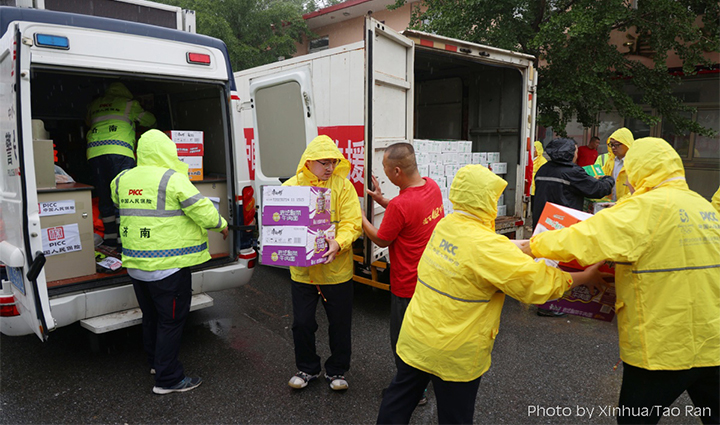



▲ Workers and volunteers move donated materials at the Sanjiadian Railway Station in Mentougou district of Beijing. [Photo by Tao Ran/China Daily]
4. Spatial Structure.
Guided by the urban spatial structure of “one core, one downtown, one subcenter, two axis lines, multiple areas, and one district”, enhance the differentiated resilience capabilities of different spatial layers to comprehensively promote the overall enhancement of the city’s resilience capacity to withstand risks.
4.1 Core area of the capital.
As a crucial area for emergency command and decision-making in times of disaster, it is the primary region to ensure the resilient safety of the capital. Efforts should be focused on strengthening urban disaster prevention and mitigation capabilities, enhancing emergency command and decision-making capabilities, improving the urban security system, and ensuring a secure and sound administrative environment.
4.2 Central area of the capital.
As a key area to ensure the resilient safety of the capital, it is essential for maintaining the city's main functions and basic operations. Priority should be given to the construction of the capital's functional support ring and urban operational support ring. Emphasis should be placed on enhancing the construction of urban safety facilities, strengthening the security operation of the lifeline system, and achieving effective mobilization of internal and external resources through the construction of a distributed and networked urban pattern to ensure the normal operation of the city's basic functions during emergencies.
4.3 Subcenter of the capital.
As a critical area for ensuring the safety of the central area of the capital and undertaking coordination and emergency handling, it should fully leverage its role as a demonstration zone. Efforts should focus on strengthening the construction of urban operational support rings, the Beijing- Tianjin-Hebei cooperative liaison ring, and the resilient support corridors, and enhancing the engineering defense capability and social response capability to create a resilient city demonstration area.
4.4 Central axis line and its extension.
As an important spatial carrier for safeguarding the functions of the capital, protecting historical and cultural heritage, and maintaining the national image, efforts should focus on organic renewal, improving urban spatial organization, enhancing the disaster-resistant capacity of buildings, upgrading the level of security facilities, carrying forward the fine historical traditions, and ensuring the normal operation of the national administration, military, culture, and international exchange functions.
4.5 Multiple areas.
As vital areas for ensuring the resilient safety of the capital, efforts should be made to strengthen the functions of urban operational support rings, the Beijing- Tianjin-Hebei cooperative liaison ring, and the eight resilient support corridors. And leverage the advantages of international aviation hubs, regional logistics bases, spatial resources, as well as regional gateways, so as to build a resilient spatial circle with self-sufficiency, interconnection, and mutual assistance.
4.6 Ecological protection areas.
As crucial regions for ensuring the sustainable development of the capital, it is essential for safeguarding the resilient safety of the capital. Efforts should focus on strengthening the functions of Beijing-Tianjin-Hebei cooperative liaison rings and resilient support corridors, enhancing the strategic reserve of resources, and ensuring contingency of water and energy supplies in times of disaster.
5. Spatial Zone.
5.1 Establish distributed resilient urban clusters with basic urban operational capabilities.
Resilient city cluster refers to spatial subdivisions within a city that can maintain basic urban operations during disasters. The clusters can provide comprehensive disaster prevention and response, ensure basic living conditions for residents, and support regional cooperation and mutual assistance in case of disaster. They possess spatial self-organization capabilities and are vital spatial carriers for maintaining the main structure and critical functions of a city and facilitating rapid recovery.
Based on the characteristics of Beijing's urban spatial structure and geographical pattern, and considering factors such as population concentration, functional distribution, and land use layout, divide the megacity into 39 medium-sized resilient urban clusters in alignment with the administrative divisions at all levels to ensure the maintenance of essential urban functions and enable rapid response and recovery through mutual assistance and support among these clusters.
5.2 Build resilient sub-districts/townships with risk management capabilities.
Resilient sub-districts/townships are spatial subdivisions within a city based on administrative boundaries of sub-districts (townships), with the goal of strengthening disaster response and implementing resilient strategies, and several resilient sub-districts/townships together form a resilient urban cluster. Taking into account the specific resilience characteristics and infrastructure shortcomings of each sub-district/township, types of resilient sub-district/township and resilient strategies should be defined, disaster response measures should be planned in advance, the resilience should be enhanced through measures such as infrastructure improvement, defenses bar raise, and facilities upgrade.
5.3 Set up resilient community life circles with neighborhood autonomy and mutual assistance.
Relying on the “15-minute community service circle”, resilience basic spatial subdivisions centered around communities should be set up. These subdivisions serve as fundamental spatial carriers for ensuring the safety of the people and organizing emergency evacuation and rescue operations. By strengthening resource-coordinated allocation and emergency response organization mobilization, a grass-roots defense line that is self-adaptive, self-organizing, and self-coordinating should be formed. In addition to firefighting, police, and sheltering, various facilities such as supermarkets, vegetable markets, pharmacies, etc. will be integrated to enhance the community’s self-organizational resilience. This approach aims to realize the transformation of dual use of peacetime and emergency, thereby improving the community’s resilience and self-organization capabilities.
Source: <https://www.beijing.gov.cn/zhengce/zhengcefagui/202403/W020240325309081232801.pdf>
Edited and Translated by Guo Xinxin